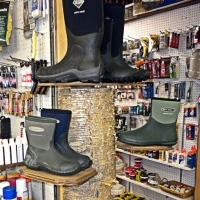 "We take orders for headstones and we sell baby food and so I guess in
"We take orders for headstones and we sell baby food and so I guess in
essence we take care of our customers from the cradle to the grave."
(HOST) All this week, we’re revisiting last summer’s tour of Vermont’s
General Stores, produced in partnership with the
Billings Farm and Museum. Today, commentator Tom Slayton considers why general
stores, once the center of village life in Vermont, eventually began to change and assume the mostly
subsidiary role they play today.
(SLAYTON)
Five changes, maybe six, happened to nudge the general store out of the
central role it played in the life of the Vermont village. The coming
of the automobile, and better roads, eventually including superhighways,
were two of those changes. Supermarkets were another. That makes three.
Number four, a big one,
was the development of mass entertainment – movies, the radio, later,
television, and eventually, the Internet. And that loaf of bread you now
buy, ready made, might be a fifth significant change. Or perhaps it’s
just a symbol of the way most of our food now is ready-made and
prepackaged.
A hundred
years ago, bread used to be made at home, with yeast and flour bought in
bulk from – the general store. There weren’t 15 or 20 different kinds
of crackers, prepackaged in boxes, available on the supermarket shelf.
There was one kind of cracker – soda crackers. They came in a barrel and
were sold by weight or count. Same thing for pickles and salt pork. The
big round of cheese at some general stores is one of the last examples
of that kind of bulk sales.
By
the early 1900s, the first supermarkets were well established. The
Atlantic & Pacific Tea Company (A&P) had more than 200 stores,
nationwide. They were self-service, which put an end to the old general
store approach, where a clerk took your list and fetched your order for
you from shelves behind his counter.
And
finally, change-factor number 6: a new system of mail service – Rural
Free Delivery (or RFD) – was instituted at the turn of the 20th century.
Country people no longer had to pick up their mail at the village post
office (which was often located at the general store). Now they could
have their own mailboxes at home.
The addition of parcel post delivery
soon after was a huge benefit to the mail-order companies like Sears
& Roebuck and Montgomery Ward. Items that formerly were bought at
the general store could be ordered and sent directly to your home.
And
the general store’s role as the center of the village’s evening
entertainment – swapping stories – was gradually eroded by radio,
television and the movies.
The
fact is, our lives, our food-buying habits, our clothing, and our
entertainments have all been transformed in the past century or so. And
every one of those changes changed the role of the general store.
But
here’s the fascinating thing: those stores still survive in today’s
Vermont. Probably because Vermont remains a village culture, the local
general store is often quite economically healthy.
They’ve
had to change to meet the changing demands of the times. But general
stores are alive and well in the Green Mountains today, meeting the
needs of their customers, and helping us get to know and better
understand the local communities they serve.